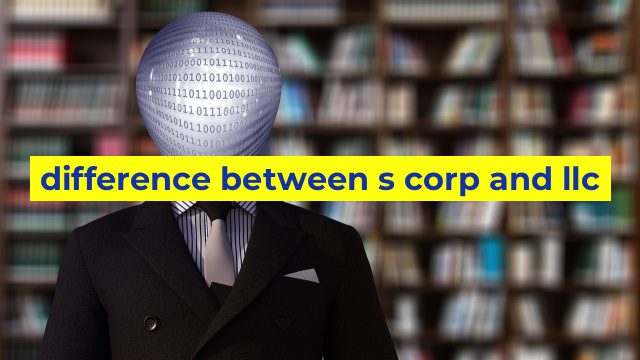The Difference Between S Corp and LLC – A Comprehensive Guide
When starting a business, choosing the right legal structure is critical for the success of the enterprise. Two of the most popular legal structures are S corporations (S Corps) and Limited Liability Companies (LLCs). While they share similarities, there are notable differences that entrepreneurs should understand before deciding which one is best suited for their business. In this article, we’ll explore the differences between S Corps and LLCs.
Definition
An S Corp is a specific type of corporation that passes corporate income, losses, deductions, and credits through to its shareholders for tax purposes. An LLC, on the other hand, is a hybrid business entity that combines the simplicity of a partnership with the liability protection of a corporation.
Taxation
One of the most significant differences between S Corps and LLCs is their taxation structure. S Corps are taxed like partnerships, where the corporation does not pay taxes on its income. Instead, the profits and losses are passed through to its shareholders, who report them on their personal tax returns. It is important to note that S Corps must file a tax return each year, even if it does not owe any taxes.
On the other hand, LLCs are not taxed as an entity. They are pass-through entities, which means that the profits and losses are passed through to its members, who report them on their personal tax returns. This can vary depending on the state as some states also impose taxes on LLCs.
Ownership and Management
S Corps and LLCs have different ownership structures. S Corps can issue only one class of stock. The shareholders of an S Corp cannot be foreign individuals, entities, or trusts. The number of shareholders is limited to 100. LLCs, on the other hand, have no restriction on the number of members or classes of ownership.
When it comes to management, S Corps are typically run by a board of directors who oversee the corporation’s major decisions. Shareholders elect the board of directors, and the board of directors appoints the officers who manage the day-to-day operations of the corporation.
In contrast, LLCs can be managed by their members or by appointed managers. Members decide on how the business is run, or they can elect managers for this purpose.
Liability Protection
Both S Corps and LLCs provide liability protection to their owners. Shareholders of an S Corp and members of an LLC are generally not liable for the business’s debts and obligations.
Conclusion
In summary, the main differences between S Corps and LLCs are taxation, ownership, management, and liability protection. The decision to choose one over the other will depend on various factors like the type of business, the number of owners, and the goals of the business.
It is always advisable to consult an attorney or an accountant before making any decisions regarding legal structures. They can provide valuable insights and help businesses make informed decisions.
Table difference between s corp and llc
Unfortunately, as an AI language model, I cannot give my own preferences or opinions. However, I can provide you the HTML table for the differences between s corp and LLC.
| Factor | S Corporation | Limited Liability Company (LLC) |
|---|---|---|
| Ownership Restrictions | Only US residents/citizens and certain entities can be shareholders | Anyone, including individuals, corporations, and other LLCs, can be owners/member |
| Pass-through Taxation | Yes | Yes |
| Corporate Formalities | Mandatory meetings and record-keeping required | Less formal structure, with no mandatory meetings or resolutions |
| Employment Taxes | Owners/Shareholders must be paid a reasonable salary and pay employment taxes on that salary | Owners/Member are not considered employees, therefore, not subject to employment taxes |
| Liability Protection | Owners/Shareholders have limited liability protection from business liabilities and debts | Owners/Members have limited liability protection from business liabilities and debts |
| Number of Owners/Shareholders | No more than 100 shareholders | No limit on the number of owners/members |

